Extina
Generic name: ketoconazole topical
Drug class: Topical antifungals
Medically reviewed by A Ras MD.
What is Extina?
Extina Foam is a prescription medicine used on the skin (topical) to treat seborrheic dermatitis in people 12 years of age and older with a normal immune system.
It is not known if Extina Foam is safe and effective when used to treat fungal infections.
It is not known if Extina Foam is safe and effective in children less than 12 years of age.
Description
EXTINA Foam contains 2% ketoconazole USP, an antifungal agent, in a thermolabile hydroethanolic foam for topical application.
The chemical name for ketoconazole is piperazine, 1-acetyl-4-[4-[[2-(2,4-dichlorophenyl) -2-(1H-imidazol-l-ylmethyl)-1,3-dioxolan-4-yl]methoxy]phenyl]-, cis– with the molecular formula C26H28Cl2N4O4 and a molecular weight of 531.43. The following is the chemical structure:

EXTINA Foam contains 20 mg of ketoconazole per gram in a thermolabile hydroethanolic foam vehicle consisting of cetyl alcohol, citric acid, ethanol (denatured with tert-butyl alcohol and brucine sulfate) 58%, polysorbate 60, potassium citrate, propylene glycol, purified water, and stearyl alcohol pressurized with a hydrocarbon (propane/butane) propellant.
Mechanism of Action
The mechanism of action of ketoconazole in the treatment of seborrheic dermatitis is not known.
What is the most important information I should know about Extina?
Extina Foam is for use on the skin only. Do not use Extina Foam in your eyes, mouth or vagina.
What should I tell my healthcare provider before using Extina?
Before using Extina Foam, tell your healthcare provider about all of your medical conditions, including if you:
- are pregnant or plan to become pregnant. It is not known if Extina Foam will harm your unborn baby.
- are breastfeeding or plan to breastfeed. It is not known if Extina passes into your breast milk. Talk to your healthcare provider about the best way to feed your baby during treatment with Extina Foam.
Tell your healthcare provider about all the medicines you take, including prescription and over-the-counter medicines, vitamins, and herbal supplements.
How should I use Extina?
- Use Extina Foam exactly as your healthcare provider tells you to use it. See the detailed Instructions for Use at the end of this leaflet for directions about how to apply Extina Foam the right way.
- Apply Extina Foam to the affected skin area(s) 2 times each day for 4 weeks. You should apply enough Extina Foam to cover the entire affected area(s).
- Talk to your healthcare provider if your skin does not improve after 4 weeks of treatment with Extina Foam.
- Dispense Extina Foam directly into the cap. Do not dispense Extina Foam directly onto your hands, because the foam will begin to melt on contact with warm skin.
- Wash your hands after applying Extina Foam.
What should I avoid while taking Extina?
- Extina Foam is flammable. Avoid fire, flames, or smoking during and right after you apply Extina Foam to your skin.
- Avoid getting Extina Foam in or near your eyes, mouth, lips or vagina. If you get Extina Foam on your lips or in your eyes, mouth or vagina, rinse well with water.
What are the possible side effects of Extina?
Extina Foam may cause serious side effects, including:
- Skin irritation at the application area(s), including skin reactions caused by exposure to light. Tell your healthcare provider if you develop skin irritation during treatment with Extina Foam.
The most common side effects of Extina Foam include, burning, dryness, redness, irritation, numbness, itching, rash and warmth at the application site.
These are not all of the possible side effects of Extina Foam.
Call your doctor for medical advice about side effects. You may report side effects to FDA at 1-800-FDA-1088.
General information about the safe and effective use of Extina
Medicines are sometimes prescribed for purposes other than those listed in a Patient Information leaflet. Do not use Extina Foam for a condition for which it was not prescribed. Do not give Extina Foam to other people, even if they have the same symptoms that you have. It may harm them. You can ask your pharmacist or healthcare provider for information about Extina Foam that is written for health professionals.
How should I store Extina?
- Store Extina Foam at room temperature between 68°F to 77°F (20°C to 25°C).
- Do not store the Extina Foam can in the refrigerator or freezer.
- Keep Extina Foam away from heat. Never throw the Extina Foam can into a fire, even if the can is empty.
- Do not store Extina Foam at temperatures above 120°F (49°C).
- Do not break through (puncture) the Extina Foam can.
Keep Extina Foam and all medicines out of the reach of children.
What are the ingredients in Extina?
Active ingredient: ketoconazole
Inactive ingredients: cetyl alcohol, citric acid, ethanol (denatured with tert-butyl alcohol and brucine sulfate) 58%, polysorbate 60, potassium citrate, propylene glycol, purified water, and stearyl alcohol pressurized with a hydrocarbon (propane/butane) propellant
For more information, call Mylan at 1-877-446-3679 (1-877-4-INFO-RX) or visit www.extina.com.
Instructions for use
Extina (ex-TEEN-ah)
(ketoconazole)
Foam, 2%
Important Information: Extina Foam is for use on the skin only. Do not use Extina Foam in your eyes, mouth or vagina.
Step 1: Remove the clear cap from the Extina Foam can.
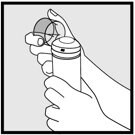
Step 2: Hold the can upright and firmly press the nozzle to dispense Extina Foam into the clear cap.
- Dispense enough Extina Foam to cover the entire affected area(s).
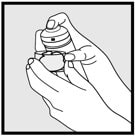
- If the can seems warm or the foam seems runny, run the can under cold water.
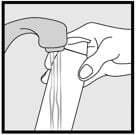
Step 3: Pick up small amounts of Extina Foam with your fingertips and gently rub the foam into the affected area(s) until the foam disappears.
 |
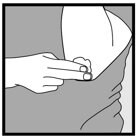 |
- If you are treating areas such as your scalp, part the hair so that Extina Foam may be applied directly to the skin.
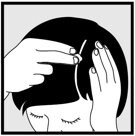
Step 4: Wash your hands after applying Extina Foam.
- Throw away any of the unused medicine that is left in the cap.
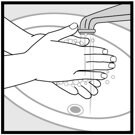
Label
PRINCIPAL DISPLAY PANEL – 2%
- NDC 0378-8136-50
- Extina®
(ketoconazole)
Foam, 2% - FOR TOPICAL USE ONLY
- Rx only 50 g
- NOT FOR OPHTHALMIC, ORAL,
OR INTRAVAGINAL USE. - Hold the can at an
upright angle and
then press firmly
to dispense.
SRC: NLM .
